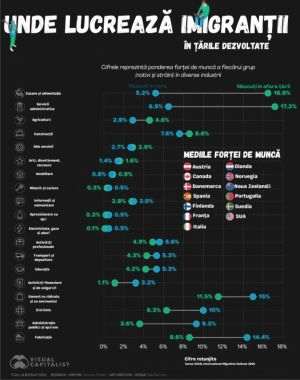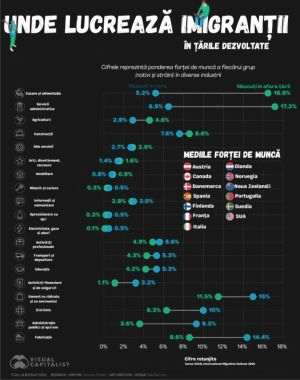Despite many countries switching from fossil fuels to cleaner ones, global coal consumption will reach an all-time high of 164 Exajoules (EJ) in 2023, according to a Visual Capitalist analysis highlighting coal's role in the energy mix globally, respectively the regions that consume large amounts of coal.
Coal is a major player in the global energy mix, contributing 26% of global energy in 2023, which is more than all non-fossil fuel sources combined. The only source of energy that had a greater contribution to the global energy mix was oil, according to the quoted source.
Coal consumption by region shows as follows: China - 91.9 EJ, respectively a share of 56.1% of the global total; Asia-Pacific (excluding China) - 43.8 EJ, 26.7% share; Americas - 10 EJ, 6.1% share; Europe - 8.4 EJ, share of 5.1%; Commonwealth of Independent States (CIS) - 5.5 EJ, share of 3.4%; Africa -4.1 EJ, 2.5% share; Middle East - 0.4 EJ, share of 0.2%.
• North America and Europe have reduced their energy consumption from coal
Coal consumption decreased, however, in many regions, according to the quoted source. For example, both North America and Europe have reduced their coal power consumption by 16% in 2023. However, a heavy dependence on coal in the Asia-Pacific region has meant that, globally, the consumption of coal to remain essentially the same over the past ten years.
In 2023, China increased its coal consumption from 88 EJ to nearly 92 EJ, accounting for 56% of global coal consumption. This has contributed significantly to the fact that Asia-Pacific is the world leader in the field, with 83% of global coal consumption.
• Coal consumption, supported by easy access to infrastructure and reasonable prices
Easy access to existing infrastructure and reasonable prices have not only supported global coal consumption over the past decade, but also paved the way for potential growth. Many developing countries are now increasing their coal consumption, presenting potential opportunities in the coal market, the aforementioned analysis notes.
For example, according to the World Energy Statistical Survey 2024, Bangladesh and Colombia recorded, between 2022 and 2023, double-digit percentage increases in coal consumption, at an annual rate: 41% and 53%, respectively.
Coal continues to play an essential role in the global energy mix, particularly in the developing world, where its affordability makes it the current energy source of choice.
• Global coal demand expected to remain flat through 2025
Despite the rapid expansion of renewables, huge increases in electricity demand in key economies indicate that in 2024 and 2025, global coal consumption will remain largely stable, according to the IEA (International Energy Agency).
Global coal demand will remain broadly flat in the coming years as rising electricity consumption in some major economies offsets the impact of a gradual recovery in hydropower and the rapid expansion of solar and wind power, according to the IEA.
The quoted source recalls that the use of coal worldwide increased by 2.6% in 2023, reaching an all-time high, based on demand from China and India, the largest consumers of coal globally. While demand for coal increased in both the power and industrial sectors, the main driver was the use of coal to fill the gap created by low hydropower production and rapidly growing electricity demand.
In China, which accounts for more than half of global coal consumption, hydropower generation recovered in 2024 from extremely low levels last year. This, along with the expansion of solar and wind power, significantly slows the growth of coal consumption in 2024. But another major annual increase in China's electricity demand, estimated at 6.5% in 2024, makes a decline in consumption unlikely of coal of the country.
In India, coal demand growth will slow in the second half of 2024 as weather conditions return to seasonal averages, the IEA notes. In the first half of the year, India's coal consumption rose sharply as a result of low hydropower production and a massive increase in electricity demand amid extreme heat waves and strong economic expansion.
Coal demand in Europe continues the downward trend that began in the late 2000s, largely due to efforts to reduce emissions in power generation.
After falling by more than 25% in 2023, coal-fired power generation in the European Union is expected to fall by almost as much this year. Coal use has also declined significantly in the United States in recent years, but stronger demand for electricity and a small shift away from coal to natural gas threaten to slow this trend in 2024.
Japan and South Korea continue to reduce their dependence on coal, although at a slower pace than Europe, according to the IEA.
"Our analysis shows that global coal demand is likely to remain largely constant until 2025, based on current policies and market trends," said Keisuke Sadamori, director of energy markets at the IEA, adding: "Rapid adoption , continued, of solar and wind power, combined with the recovery of hydropower in China, is putting significant pressure on the use of coal. But the electricity sector is the main driver of global coal demand, and electricity consumption is growing very strongly in several major economies. Without such rapid growth in electricity demand, we would see a decline in global coal use this year. Working structural trends show that global coal demand will reach a tipping point and begin to decline soon."
• IEA: World coal production - expected to decline slightly in 2024
On the supply side, global coal production is expected to decline slightly in 2024, after a steady increase in the previous year. In 2024, China's coal production is moderate, after two years of massive growth. In India, the drive to boost coal production continues, with supply growth of around 10% expected in 2024. In advanced economies, coal production is declining, broadly reflecting demand.
The IEA finds that trade volumes are at their highest levels ever, despite a collapse in imports in Europe and a decline in North-East Asia since 2017. However, other countries are stepping in to take up available products to be shipped . In 2024, Vietnam is set to become the fifth largest importer of coal, surpassing Chinese Taipei. In China and India, imports remain at historic highs.
Despite falling domestic production in China in the first half of this year, tougher sanctions on Russian producers and disruptions in several exporting countries, the global coal market is well supplied, according to the report. With natural gas prices more stable than in recent years, coal prices have been limited in the first half of 2024. Even though they have returned to pre-global energy crisis levels, they remain high due to inflationary pressures.





























































